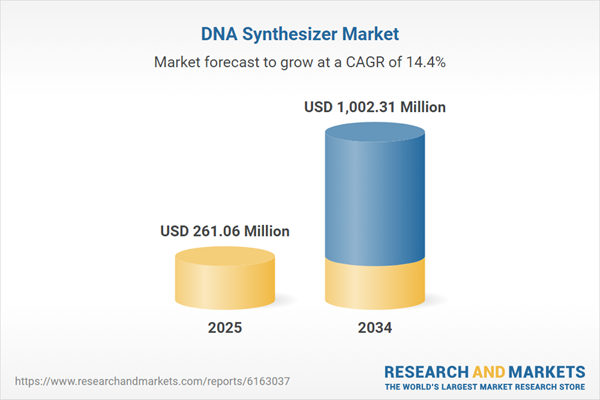DNA Synthesizer: Introduction
DNA synthesizers are devices that produce DNA molecules with a specific sequence of nucleotides. These molecules can be utilized to treat diseases by replacing damaged DNA with repaired sections. A DNA synthesizer is a crucial laboratory instrument used to chemically create or synthesize DNA molecules. It plays a vital role in molecular biology, genetics, and biotechnology research, as it enables scientists to design custom DNA sequences for different purposes, including cloning, gene expression studies, genetic engineering, and DNA sequencing.Global DNA Synthesizer Market Analysis
The increasing demand for DNA synthesis technology is due to the widespread application in research to better understand the mechanisms of disease and in the drug discovery process to combat disease is a major trend influencing the market growth.The continuous research and development activities by biotech firms and other institutions are also majorly contributing to the global DNA synthesizer market growth. For example, recently this year, Ansa Biotechnologies, Inc. claimed a successful creation of the world's longest DNA oligonucleotide in a single synthesis. The 1005-base sequence codes for a key part of an adeno-associated virus vector used to develop gene therapy.
The market is experiencing heavy investments by synthetic biology companies that are interested in developing new technological advancements in this area, further expected to expand the market growth. For example, a UK-based synthetic biology company, Camena Bioscience, recently announced the closing of a USD 10 million Series A financing round, led by Mercia, a UK-based venture capital firm. Camena aims to scale operations and continue developing gSynth, its enzyme-based DNA synthesis platform.
Global DNA Synthesizer Market Segmentations
DNA Synthesizer Market Report and Forecast 2025-2034 offers a detailed analysis of the market based on the following segments:Market Breakup by Type
- Benchtop DNA Synthesizers
- Large-scale DNA Synthesizers
Market Breakup by Application
- Research and Development
- Academic
- Industrial
- Diagnosis
- Therapeutics
Market Breakup by End User
- Biopharmaceutical Companies
- Academic and Research Institutes
- Contract Research Organizations
Market Breakup by Region
- North America
- Europe
- Asia Pacific
- Latin America
- Middle East and Africa
Global DNA Synthesizer Market Overview
The growth of the market is expected to be driven by the increasing demand for efficient DNA synthesizers from life science laboratories and pharmaceutical and biotechnology companies. Another key factor is the rapid developments in genomics and life sciences, boosting the market growth further. The increasing significance of DNA synthesizers in synthetic and molecular biology is also supporting the market growth. The market is also experiencing high demand for nucleic acid synthesis platforms among several end users, further propelling the global DNA synthesizer market growth.The increasing technological advancements are also a key factor driving the global market. The proven efficacy of benchtop DNA synthesizers as they increase the speed and efficiency of research in academic and industrial labs is contributing to the increased demand in the market, further expected to boost the growth of the market in the coming years.
The efforts to lower the cost of synthesizing DNA oligonucleotides and commercialize scalable DNA synthesizers are continuously increasing. Significant progress has been made towards the goal of affordable DNA synthesis with microfluidic/microarray oligonucleotide synthesis methods and improvements in synthetic DNA quality.
Furthermore, ongoing advancements in other efficient synthesis technologies are also expected to make synthesizers widely available at lower costs, adding further value to the global DNA synthesizer market share.
North America is currently leading the global market and is expected to keep leading throughout the forecast period due to the presence of several key players in the market and their continuous developments. Moreover, the market is also driven by ongoing technological advancements, increased investment in research and development activities, and growing demand for innovative synthesizers.
Global DNA Synthesizer Market: Competitor Landscape
The key features of the market report include patent analysis, grants analysis, clinical trials analysis, funding and investment analysis, partnerships, and collaborations analysis by the leading key players. The major companies in the market are as follows:- LGC Biosearch Technologies
- Bioneer Corporation
- Thermo Fisher Scientific, Inc.
- IBA GmbH
- Twist Bioscience
- Eton Bioscience
- Quintara Biosciences
- Eurofins Scientific
- Integrated DNA Technologies, Inc
- Integrated DxNA Technologies, Inc
This product will be delivered within 3-5 business days.
Table of Contents
Companies Mentioned
- LGC Biosearch Technologies
- Bioneer Corporation
- Thermo Fisher Scientific, Inc.
- IBA GmbH
- Twist Bioscience
- Eton Bioscience
- Quintara Biosciences
- Eurofins Scientific
- Integrated DNA Technologies, Inc
- Integrated DxNA Technologies, Inc
Table Information
| Report Attribute | Details |
|---|---|
| No. of Pages | 350 |
| Published | July 2025 |
| Forecast Period | 2025 - 2034 |
| Estimated Market Value ( USD | $ 261.06 Million |
| Forecasted Market Value ( USD | $ 1002.31 Million |
| Compound Annual Growth Rate | 14.4% |
| Regions Covered | Global |
| No. of Companies Mentioned | 10 |









